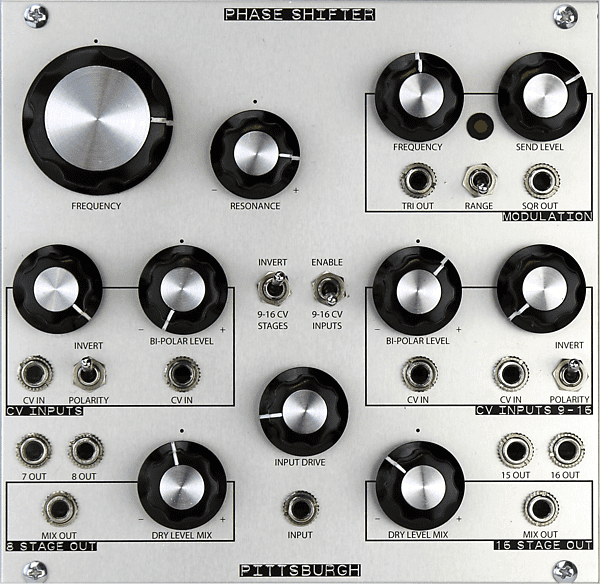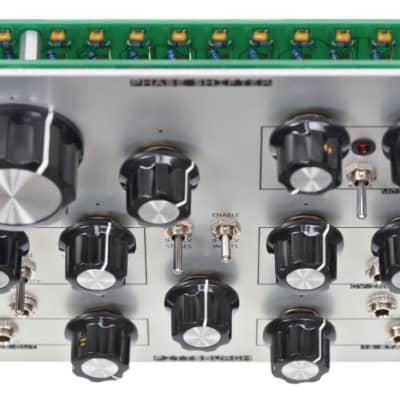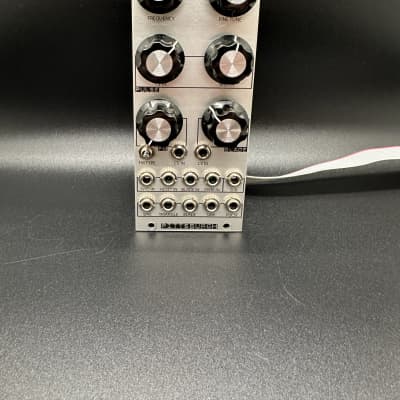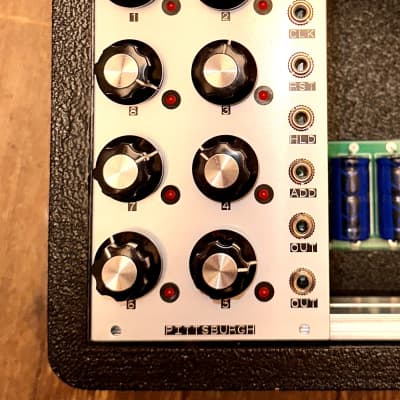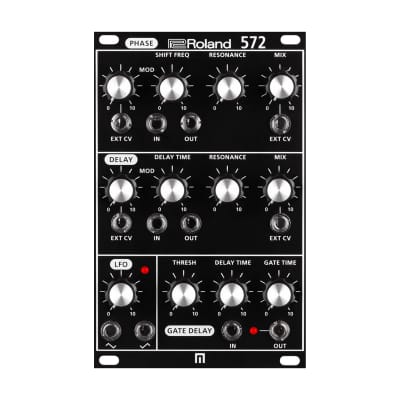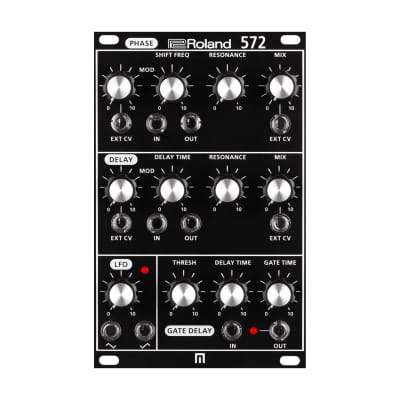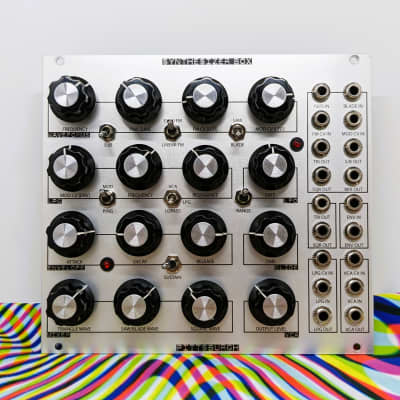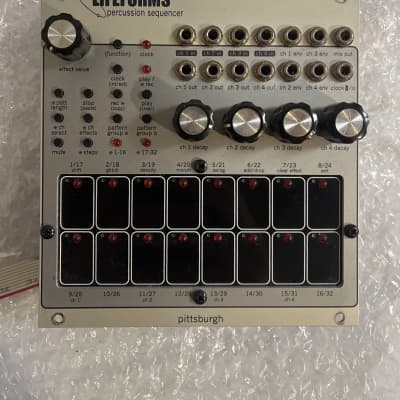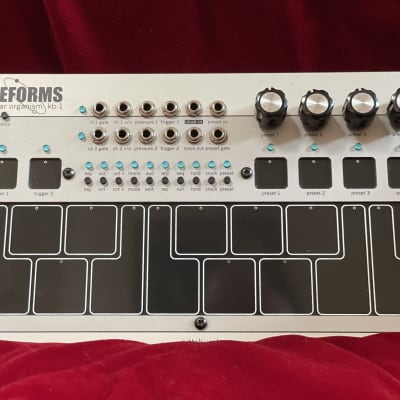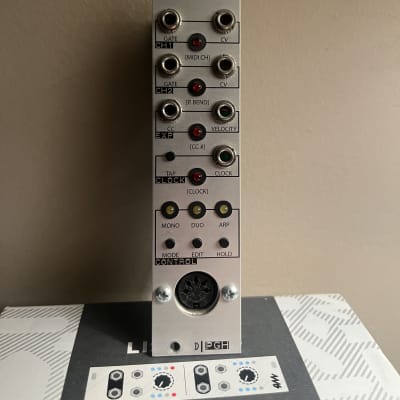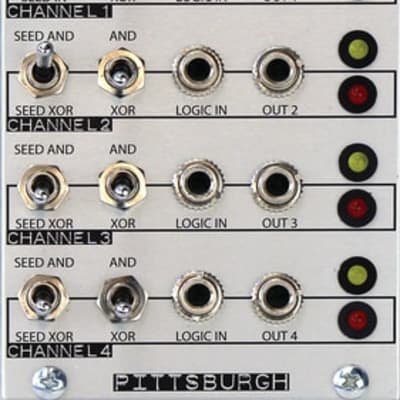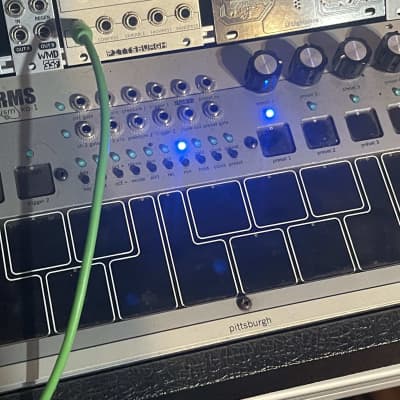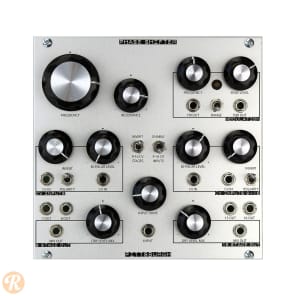Phase Shifter - 16 Stage Analog Phase Shifter
- Brand new, no scratches or rack rash. Factory clean. -
The Pittsburgh Modular Phase Shifter is a complex, 16 stage, analog effect module designed to expand on the classic swirls, rich swooshes, and doppler effects associated with the phaser.
The Phase Shifter has a single 16 stage audio signal path to create a very rich, full sound. Phased audio outputs are tapped from stages 7, 8, 15, and 16. Stages 8 and 16 each have a mix output that allow the phased signal to be mixed with an attenuvertable dry signal.
Four CV inputs, an onboard LFO, and multiple CV routing options allow for maximum flexibility and extremely deep modulation options. The CV inputs are split into 2 groups. The first group of CV inputs controls either all 16 stages or just stages 1-8. The second group of CV input controls stages 9-16 and is switchable on or off. All CV signals routed to stages 9-16 can be inverted. Resonance can be positive or negative and the module will self oscillate in either direction.
To modulate the phase shifter circuit, the module includes a wide range low frequency oscillator. The LFO range varies from 1 minute per cycle to well into audio range. The triangle wave of the LFO is hardwired to modulate the frequency of all 16 channels of the Phase Shifter. External modulation sources are handled using 2 sets of CV inputs. Each set includes an invertible, uni-polar CV input that accepts 0v to 5v modulation signals and a bi-polar CV input which accepts -5v to +5v signals. All of the modulation CV inputs can be used simultaneously and can be mixed with the internal LFO to create very complex frequency modulations. Stages 1-8 and 9-16 can be modulated together or independently using the available switches and CV inputs.
HISTORY AND THEORY BEHIND THE PHASE SHIFTER
The origin of the phase shifter as an electronic effect starts with the studio tape technique of flanging. The technique involved playing identical copies of audio through two different tape machines simultaneously and pressing on the flange of one machine to slow down the tape. This action shifted the sound slightly out of sync to the first tape machine and created a moving notch filter effect.
Electronically, the effect is created using a series of all-pass filters. Each all-pass filter stage shifts the phase of the audio signal by 90°. Chaining a series of all-pass filters together creates a larger amount of shift and a richer sounding effect. Mixing the dry, unshifted signal with the wet, shifted signal produces a notch filter effect. The notch filter effect is caused by the interaction of the 2 waves. Some frequencies are canceled out and some are reinforced creating peaks and troughs in the frequency spectrum. For every 2 stages (180° of shift) another peak and trough is created. More notches in a notch filter the deeper the effect. The real magic of the phase shifter becomes apparent when the center frequency of each stage is modulated using an triangle wave or other modulation source to produce the signature sweeping sound.
HISTORY AND THEORY BEHIND THE PHASE SHIFTER
The origin of the phase shifter as an electronic effect starts with the studio tape technique of flanging. The technique involved playing identical copies of audio through two different tape machines simultaneously and pressing on the flange of one machine to slow down the tape. This action shifted the sound slightly out of sync to the first tape machine and created a moving notch filter effect.
Electronically, the effect is created using a series of all-pass filters. Each all-pass filter stage shifts the phase of the audio signal by 90°. Chaining a series of all-pass filters together creates a larger amount of shift and a richer sounding effect. Mixing the dry, unshifted signal with the wet, shifted signal produces a notch filter effect. The notch filter effect is caused by the interaction of the 2 waves. Some frequencies are canceled out and some are reinforced creating peaks and troughs in the frequency spectrum. For every 2 stages (180° of shift) another peak and trough is created. More notches in a notch filter the deeper the effect. The real magic of the phase shifter becomes apparent when the center frequency of each stage is modulated using an triangle wave or other modulation source to produce the signature sweeping sound.
PHASE SHIFTER CONTROL DESCRIPTIONS
Frequency Control Knob:Adjusts the center frequency.
Resonance Control knob: Adjusts the amount of resonance.
LFO Frequency Control Knob: Adjusts the rate of the LFO.
LFO Send Level:Adjusts the amount of LFO used to modulate the frequency. Full left is off.
LFO Triangle Wave Out and Square Wave Out: Individual LFO waveform outputs.
LFO Range Switch: Adjust the frequency range of the LFO.
CV Inputs Uni-Polar CV In Control Knob, CV Input, and Invert Switch: Main uni-polar CV input for all 16 stages. Control knob adjusts the incoming CV level. Invert switch inverts the incoming CV signal.
CV Inputs Bi-Polar CV In Control Knob and CV Input: Main bi-polar CV input for all 16 stages. Control knob adjusts the incoming CV level.
Enable CV Inputs 9-16 Switch: Enables or disables CV Inputs 9-16 section. When enabled, external modulation for stages 9-16 uses the CV Inputs 9-16 section instead of the CV Inputs section.
Invert CV Stages 9-16 Switch: Invert switch inverts the modulation source for stages 9-16.
CV Inputs 9-16 Uni-Polar CV In Control Knob, CV Input, and Invert Switch:Alternative uni-polar CV input for stages 9-16. Control knob adjusts the incoming CV level. Invert switch inverts the incoming CV signal.
CV Inputs 9-16 Bi-Polar CV In Control Knob and CV Input: Alternative bi-polar CV input for stages 9-16. Control knob adjusts the incoming CV level.
8 Stage Out Static Wave Blender Control Knob and Mix Output: Mix of the unphased dry signal and the output of the 8th stage of the Phase Shifter. The Static Wave Blender is an attenuverter for the dry signal.
Stage 7 Output: Output of the 7th stage of the Phase Shifter.
Stage 8 Output: Output of the 8th stage of the Phase Shifter.
16 Stage Out Static Wave Blender Control Knob and Mix Output: This is the main mix out. Mix of the unphased dry signal and the output of the 16th stage of the Phase Shifter. The Static Wave Blender is an attenuverter for the dry signal.
Stage 15 Output: Output of the 15th stage of the Phase Shifter.
Stage 16 Output: Output of the 16th stage of the Phase Shifter.
Input Drive Knob: Audio signal input level control.
Input Jack: Audio Signal Input
Phase Shifter Specs
Size: 26hp
Depth: 35mm
Power Usage: +12v 175mA, -12v 155mA. Does not require +5v.
Contact for shipping prices outside of the U.S. continental 48
